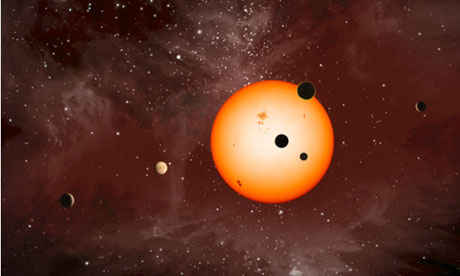 It might not seem obvious why anyone should care what's happening on the other side of the Sun. But NASA can explain: our home star is a seething, roiling ball of superhot gas that goes through cycles of relative quiet, punctuated by violent outbursts. Every so often, the Sun spits out a blob of charged subatomic particles — and occasionally, one of them is aimed directly at the Earth.
It might not seem obvious why anyone should care what's happening on the other side of the Sun. But NASA can explain: our home star is a seething, roiling ball of superhot gas that goes through cycles of relative quiet, punctuated by violent outbursts. Every so often, the Sun spits out a blob of charged subatomic particles — and occasionally, one of them is aimed directly at the Earth.
These eruptions, known as coronal mass ejections, aren't enough to hurt the planet physically; they're very hot, but also very insubstantial. What they can do is fry the electronics of communications satellites, and even put astronauts in danger of a radiation overdose.
NASA Images the Entire Sun, Far Side and All
Nasa scientists discover planetary system
 Astronomers have discovered a planetary system made up of six planets orbiting a Sun-like star that is more than 2,000 light years from Earth. It is the largest number of planets found so far around a single star. More than 100 planets have been seen outside our solar system, but most are Jupiter-like gas giants, and almost all are in single-planet systems.
Astronomers have discovered a planetary system made up of six planets orbiting a Sun-like star that is more than 2,000 light years from Earth. It is the largest number of planets found so far around a single star. More than 100 planets have been seen outside our solar system, but most are Jupiter-like gas giants, and almost all are in single-planet systems.
Jack Lissauer, a scientist at Nasa's Ames research centre in California and a lead author on a paper published tomorrow in the journal Nature, said that the Kepler-11 finding was "the biggest thing in exoplanets since the discovery of 51 Pegasi B, the first exoplanet, back in 1995".
Gazing Afar for Other Earths, and Other Beings
 In a building at NASA’s Ames Research Center here, computers are sifting and resifting the light from 156,000 stars, seeking to find in the flickering of distant suns the first hints that humanity is not alone in the universe. The stars are being monitored by a $600 million satellite observatory named Kepler, whose job is to conduct a kind of Gallup poll of worlds in the cosmos.
In a building at NASA’s Ames Research Center here, computers are sifting and resifting the light from 156,000 stars, seeking to find in the flickering of distant suns the first hints that humanity is not alone in the universe. The stars are being monitored by a $600 million satellite observatory named Kepler, whose job is to conduct a kind of Gallup poll of worlds in the cosmos.
On Wednesday, Kepler’s astronomers are scheduled to unveil a closely kept list of 400 stars that are their brightest and best bets so far for harboring planets, some of which could turn out to be the smallest and most Earth-like worlds discovered out there to date. They represent the first glimpse of riches to come in a quest that is as old as the imagination and as new as the iPad.
Research: Early modern humans left Africa earlier than thought
 The discovery of an ancient stone tool kit in the United Arab Emirates, reported in today's edition of the journal Science, now is raising the possibility that today's modern humans first started leaving Africa earlier than paleontologists previously thought.
The discovery of an ancient stone tool kit in the United Arab Emirates, reported in today's edition of the journal Science, now is raising the possibility that today's modern humans first started leaving Africa earlier than paleontologists previously thought.
The question of when modern humans first started leaving the African continent has been debated since the 1980s. African fossils of modern-looking humans date to about 200,000 years ago, but gene studies of non-Africans suggest that people only left the mother continent by 60,000 years ago.
Hubble telescope detects the oldest known galaxy
 The Hubble Space Telescope has detected what scientists believe may be the oldest galaxy ever observed. It is thought the galaxy is more than 13 billion years old and existed 480 million years after the Big Bang.
The Hubble Space Telescope has detected what scientists believe may be the oldest galaxy ever observed. It is thought the galaxy is more than 13 billion years old and existed 480 million years after the Big Bang.
A Nasa team says this was a period when galaxy formation in the early Universe was going into "overdrive". The image, which has been published in Nature journal, was detected using Hubble's recently installed wide field camera.
N.R.A. Stymies Firearms Research, Scientists Say
 In the wake of the shootings in Tucson, the familiar questions inevitably resurfaced: Are communities where more people carry guns safer or less safe? Does the availability of high-capacity magazines increase deaths? Do more rigorous background checks make a difference?
In the wake of the shootings in Tucson, the familiar questions inevitably resurfaced: Are communities where more people carry guns safer or less safe? Does the availability of high-capacity magazines increase deaths? Do more rigorous background checks make a difference?
The reality is that even these and other basic questions cannot be fully answered, because not enough research has been done. And there is a reason for that. Scientists in the field and former officials with the government agency that used to finance the great bulk of this research agree in saying that the influence of the National Rife Association has all but choked off money for such work.
Scientists fear kilograms don't weigh as much as they used to
 When is a kilogram not a kilogram? When it starts to weigh less. It came into existence more than two centuries ago and has become the standard unit of weight around the world, from the shopping malls of Europe to the souks of the Middle East, but scientists believe that the reign of the kilo as we know it is about to come to an end.
When is a kilogram not a kilogram? When it starts to weigh less. It came into existence more than two centuries ago and has become the standard unit of weight around the world, from the shopping malls of Europe to the souks of the Middle East, but scientists believe that the reign of the kilo as we know it is about to come to an end.
A group of experts meeting in London today want to redefine the kilogram so that it is no longer based on the mass of a solid cylinder of platinum-iridium alloy that sits beneath three layers of protective glass sealed in a locked vault in Sèvres, France.
More Articles...
Page 43 of 62

 Science Glance
Science Glance






























